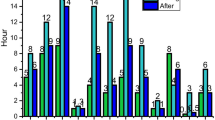Abstract
Even though occupancy inference is of utmost importance for numerous real-time and real-life applications a widely-accepted approach to predict occupancy does not exist. In this paper, an assessment of widely-recommended approaches and data processing for occupancy is overviewed. Furthermore, the correlation and meta-analysis between various sensor features like motion sensing, temperature, humidity, and energy consumption were tested. Random Forest classifier a widely-applied artificial model for occupancy inference prediction is evaluated in 4 different real-life data sets including various features. The results of both a univariate and multivariate model are examined. Random Forest classifier results during an experimental phase are presented to reveal the best model. The outcomes of the current research indicate that even in similar spaces data analysis and correlation have different results while the multivariate model is more accurate than the bivariate model.
Access this chapter
Tax calculation will be finalised at checkout
Purchases are for personal use only
Similar content being viewed by others
References
Dimara, A., Krinidis, S., Tzovaras, D.: occupI: a novel non-intrusive occupancy inference tool. In: 2020 International Conferences on Internet of Things (iThings) and IEEE Green Computing and Communications (GreenCom) and IEEE Cyber, Physical and Social Computing (CPSCom) and IEEE Smart Data (SmartData) and IEEE Congress on Cybermatics (Cybermatics). IEEE (2020)
Salimi, S., Hammad, A.: Critical review and research roadmap of office building energy management based on occupancy monitoring. Energy Build. 182, 214–241 (2019)
Jafarinejad, T., et al.: Bi-level energy-efficient occupancy profile optimization integrated with demand-driven control strategy: university building energy saving. Sustain. Cities Soc. 48, 101539 (2019)
Luo, K., et al.: Safety-oriented pedestrian occupancy forecasting. In: 2021 IEEE/RSJ International Conference on Intelligent Robots and Systems (IROS). IEEE (2021)
Jung, W., Jazizadeh, F.: Human-in-the-loop HVAC operations: a quantitative review on occupancy, comfort, and energy-efficiency dimensions. Appl. Energy 239, 1471–1508 (2019)
Rueda, L., et al.: A comprehensive review of approaches to building occupancy detection. Build. Environ. 180, 106966 (2020)
Wang, X., Wang, C.: Time series data cleaning: a survey. IEEE Access 8, 1866–1881 (2019)
Kenda, K., Mladenić, D.: Autonomous sensor data cleaning in stream mining setting. Bus. Syst. Res. Int. J. Soc. Adv. Innov. Res. Econ. 9(2), 69–79 (2018)
Saha, H., et al.: Occupancy sensing in buildings: a review of data analytics approaches. Energy Build. 188, 278–285 (2019)
Golestan, S., Kazemian, S., Ardakanian, O. : Data-driven models for building occupancy estimation. In: Proceedings of the Ninth International Conference on Future Energy Systems (2018)
Kutafina, E., et al.: Recursive neural networks in hospital bed occupancy forecasting. BMC Med. Inform. Decis. Mak. 19(1), 1–10 (2019)
Hepler, S.A., Erhardt, R.J.: A spatiotemporal model for multivariate occupancy data. Environmetrics 32(2), e2657 (2021)
Barter, R.L., Bin, Yu.: Superheat: an R package for creating beautiful and extendable heatmaps for visualizing complex data. J. Comput. Graph. Stat. 27(4), 910–922 (2018)
Verma, V., et al.: Interpolation consistency training for semi-supervised learning. arXiv preprint arXiv:1903.03825 (2019)
Saad, M., et al.: Machine learning based approaches for imputation in time series data and their impact on forecasting. In: 2020 IEEE International Conference on Systems, Man, and Cybernetics (SMC). IEEE (2020)
Jia, B.B., Zhang, M.L.: Multi-dimensional classification via decomposed label encoding. IEEE Trans. Knowl. Data Eng. (2021)
Amayri, M., et al.: Estimating occupancy in heterogeneous sensor environment. Energy Build. 129, 46–58. Zeigermann, Lars (2016)
TIMESTAMP: Stata module to obtain a UNIX timestamp and the current time of a user-specified timezone (2016)
Denis, D.J.: SPSS Data Analysis for Univariate, Bivariate, and Multivariate Statistics. John Wiley & Sons, Hoboken (2018)
Liebhold, A.M., Sharov, A.A.: Testing for Correlation in the Presence of Spatial Autocorrelation in Insect Count Data. Population and Community Ecology for Insect Management and Conservation, pp. 111–118. CRC Press, Boca Raton (2020)
Tharwat, A.: Classification assessment methods. Appl. Comput. Inform. 17(1), 168–192 (2021). https://doi.org/10.1016/j.aci.2018.08.003
Acknowledgements
The research leading to these results was partially funded by the European Commission “LC- EEB-07-2020 - Smart Operation of Proactive Residential Buildings” - PRECEPT H2020 project (Grant agreement ID: 958284) https://www.precept-project.eu/, accessed on 8 March 2022; and “LC-SC3-B4E-3-2020 Upgrading smartness of existing buildings through innovations for legacy equipment” - Smart2B H2020 project (Grant agreement ID: 101023666) https://www.smart2b-project.eu/, accessed on 2 March 2022.
Author information
Authors and Affiliations
Corresponding author
Editor information
Editors and Affiliations
Rights and permissions
Copyright information
© 2022 IFIP International Federation for Information Processing
About this paper
Cite this paper
Dimara, A. et al. (2022). Environmental Feature Correlation and Meta-analysis for Occupancy Detection - A Real-Life Assessment. In: Maglogiannis, I., Iliadis, L., Macintyre, J., Cortez, P. (eds) Artificial Intelligence Applications and Innovations. AIAI 2022 IFIP WG 12.5 International Workshops. AIAI 2022. IFIP Advances in Information and Communication Technology, vol 652. Springer, Cham. https://doi.org/10.1007/978-3-031-08341-9_21
Download citation
DOI: https://doi.org/10.1007/978-3-031-08341-9_21
Published:
Publisher Name: Springer, Cham
Print ISBN: 978-3-031-08340-2
Online ISBN: 978-3-031-08341-9
eBook Packages: Computer ScienceComputer Science (R0)





